
The World’s Last Seagoing Paddle Steamer
[caption id="RidingtheWaverley_Feature" align="aligncenter" width="1024"]
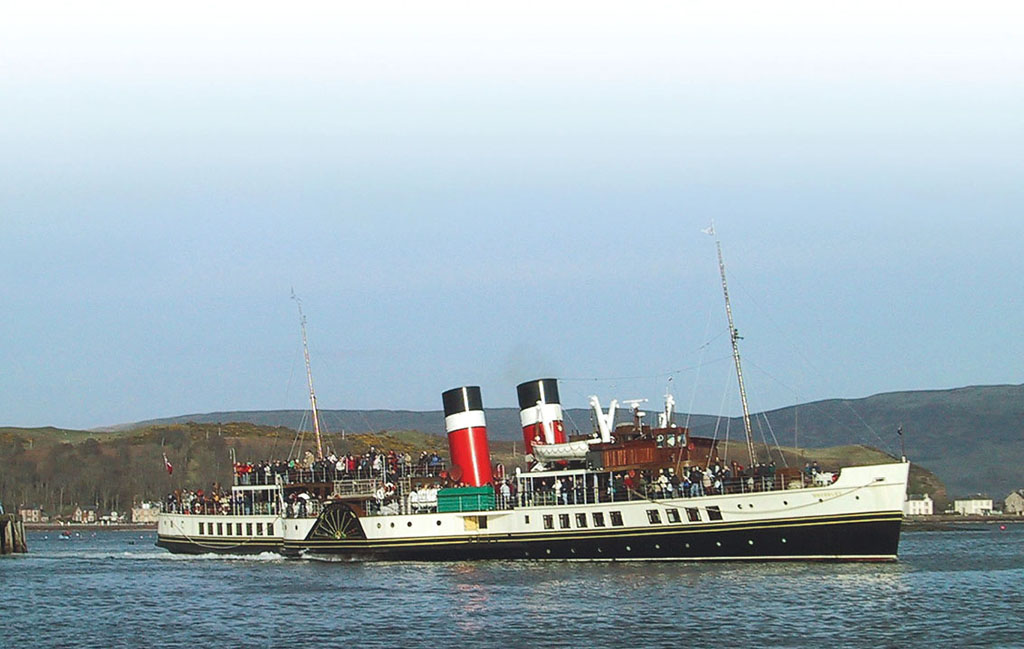
SANDRA LAWRENCE
Bright sunshine has burned through the morning fog, ushering in a crisp October day. The air of excitement exuded by people old enough to know better is almost palpable as we join the queues in the shadow of the Tower. For today, Londoner though I may be, I venture farther downstream than I have ever been before—aboard the good ship Waverley, the last remaining seagoing paddle steamer in the world.
Waverley spent most of her working life in Scotland, where she’s now based, waiting in all her restored charm for spring, when she makes stately progress around the British Isles, stopping at various ports to give excursions to day trippers, boat lovers and steam enthusiasts. From the Scottish lochs round the North West Coast, through the Irish Sea, down to Bristol, past the historic ships at Portsmouth and the rocks of Lulworth Cove, she finally heads up the Thames every October.
Everything about Waverley gleams. Her brasswork shines and her paintwork shimmers. Her twin funnels are festooned in carefully-researched original colors, and the varnish on the woodwork is thick and lustrous—testament to the love which her owners, the Paddle Steamer Preservation Society, have lavished on Waverley every year since they bought her mouldering hulk for r£1 back in the 1970s. That they have managed to not only get her steam engines working again, but paying for herself with fare-paying passengers is a matter of no small pride for the tiny charity.
A deep blast from the horn and a cloud of steam from the funnels signal the folks at Tower Bridge to ready themselves. One of the great joys for me is that after living in London all my life, not only do I finally get to see Tower Bridge open—but open for me. Traffic on the bridge is at a standstill, and tourists are gathering either side as Waverley’s little tug guides her round and toward the slowly lifting sides, silhouetted in the dazzling sunshine.
The morning’s fog lingers in the distance, giving the impression that we are somehow headed for the ends of the earth. As we glide through the legendary portals, the crowds above us are cheering almost as much as we, and the horn sounds long and joyful. The paddles churn the almost flat Thames; I have never seen it as still as this.
The first part of the journey I am reasonably familiar with. It’s the route I often take on the Thames Clippers, winding through East London, past old warehouses, now turned into smart offices and sumptuous apartments with balconies—where I confess I have never seen their occupants coming out in their dressing gowns, mugs of tea in hand, to wave at a river bus. But there they are, waving at us; we wave back. Historic Limehouse and Canary Wharf to starboard. Rotherhithe and Deptford Creek to port, all bathed in pale autumn sunshine.
We’re slowing down. We haven’t reached Greenwich yet but farther down the river it is still a regular pea-souper, Guv. The Thames Barrier is wreathed in mist; we proceed at a snail’s pace. As we glide past the Dome, toward the barrier, things get creepy. Now the horn is being used for real….
[caption id="RidingtheWaverley_img1" align="aligncenter" width="246"]
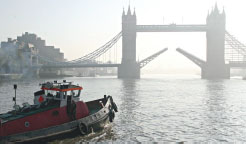
SANDRA LAWRENCE
For the next hour we creep through Fairyland. Later I am to discover that the twinkling lights, grey turrets and towers castling through the mists are actually London’s industrial heartland—power stations, factories, wind farms, scrap metal dealers—but for now they are magical, as is the looming Queen Elizabeth II Bridge, taking M25 traffic from Essex to Kent.
Feeling suddenly chilly, we head below. Waverley has no fewer than five restaurants, cafés and bars. The two main lounges are strongly art deco in theme, serving traditional English food. In between lies the heart of the ship, pumping away for all to see. Crowds are gathered to watch immaculately restored steam engines, resplendent in their original deep green and red livery, their great pistons now punching flat-out as we head toward Tilbury.
This is fort country, England’s shaky relationship with her nearneighbors played out before us in the form of historic battlements, many of them Napoleonic. Tilbury Fort, where Queen Elizabeth I made her famous “weak and feeble woman/ heart and stomach of a king” speech; Coalhouse Fort, with its barracks and gun ports hastily remodeled for WWII. Cliffe, dating to the mid-19th century. A wartime radar station disguised as a water tower. The river is wider here, its mouth blurred into the sea, its waters remaining curiously still. There’s not a ripple, not a breath of air to hasten away the mist, which lingers as a thin haze watering the sun. A group of Sea Scouts comes alongside to wave.
[caption id="RidingtheWaverley_img2" align="aligncenter" width="280"]
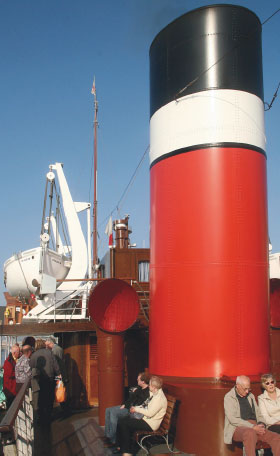
COURTESY OF WAVERLEY EXCURSIONS LTD.
Many people get off the ship at the Victorian resort of Southend, home of kiss-me-quick hats, donkey rides, seaside rock—and the longest pier in the world, complete with its own railway. We’re staying onboard, though, for an extra cruise along the river Medway, joined by another wave of visitors. There are now 685 people on board and it feels tight.
Bathed by pale midday sun, the Kent marshes retain, in the thin fog, the air of mystery that encouraged generations of smugglers to take risks on their treacherous banks. Waverley creeps past more power stations, more Napoleonic forts; and we decide to check out a few more bars. The dedicated whisky bar in the very bowels of the boat is snug and male; one, I would say, for a bitter winter’s storm.
[caption id="RidingtheWaverley_img3" align="aligncenter" width="377"]
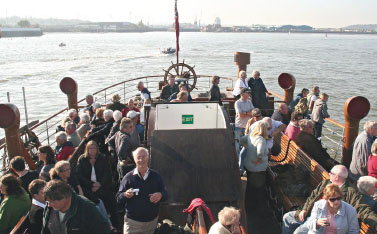
SANDRA LAWRENCE
[caption id="RidingtheWaverley_img4" align="aligncenter" width="775"]
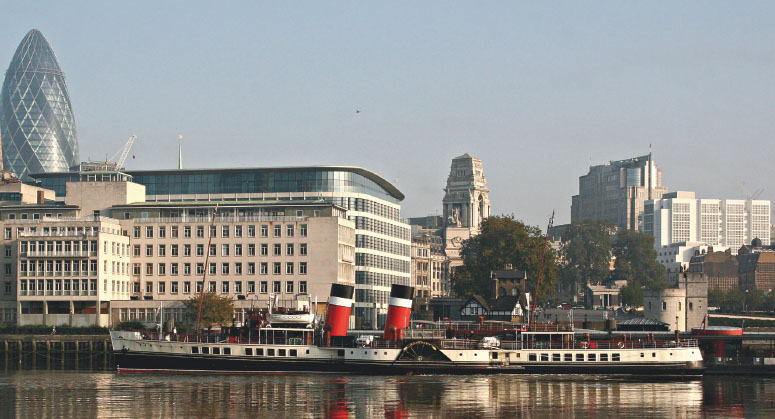
SANDRA LAWRENCE
Since Waverley’s too big to make it into the Historic Dockyard at Chatham, the highlight of the Medway tour is the meeting with the Society’s other steamer, the 1924 river paddler Kingswear Castle, also crowded with excited passengers. The two boats pass each other, honking their horns and blasting funnels of smoke in holiday mood—it is Waverley’s last trip down the Thames this year and they’re making the most of it.
By the time we reach Southend for the final leg of the trip back up to London, haze has turned to dusk. We slide silently back along dark banks; what was Fairyland has turned into a goblinesque labyrinth of shadows and silhouettes. Giant electricity pylons, high enough for ships to pass beneath; looming back-up power stations awaiting their moment of glory when England’s stocks become low.
As towns gradually replace marshes, the twinkling lights become glowing windows and Reality beckons. The Old Royal Naval College and Queen’s House are floodlit in white and the single green laser marking the Meridian Line shoots out from the Observatory on the hill. The warehouses-turned-luxury flats of Docklands have come to life; we silently witness their occupants having dinner, chatting over a glass of wine, watching TV.
Once again the postcard-perfect turrets of Tower Bridge loom into sight, creaking open streetlight-drenched arms against the dark blue of the night sky. Waverley’s trip is nearly over, and I am back in England from whatever world I have been in.
Details of all the trips on Waverley can be found at www.waverleyexcursions.co.uk.





Comments